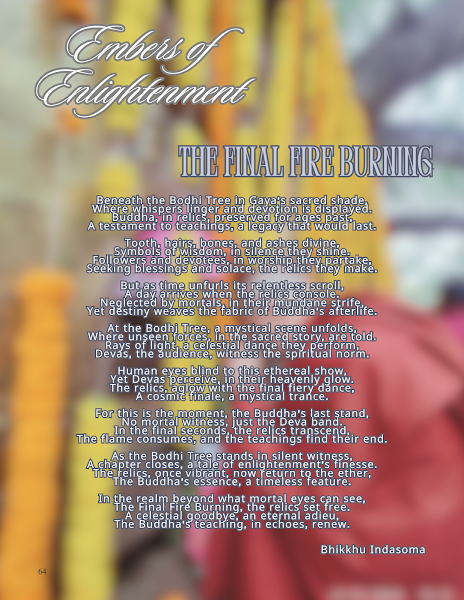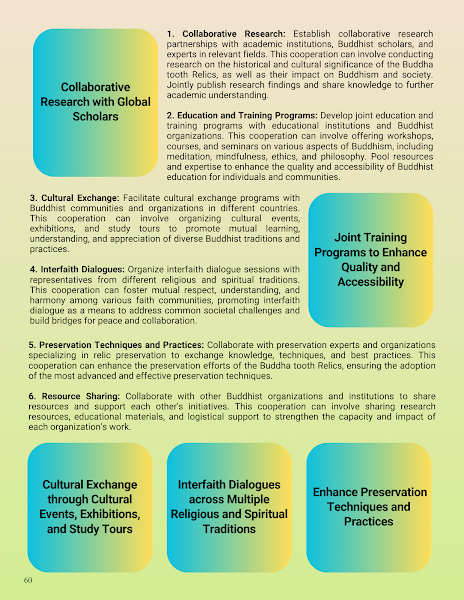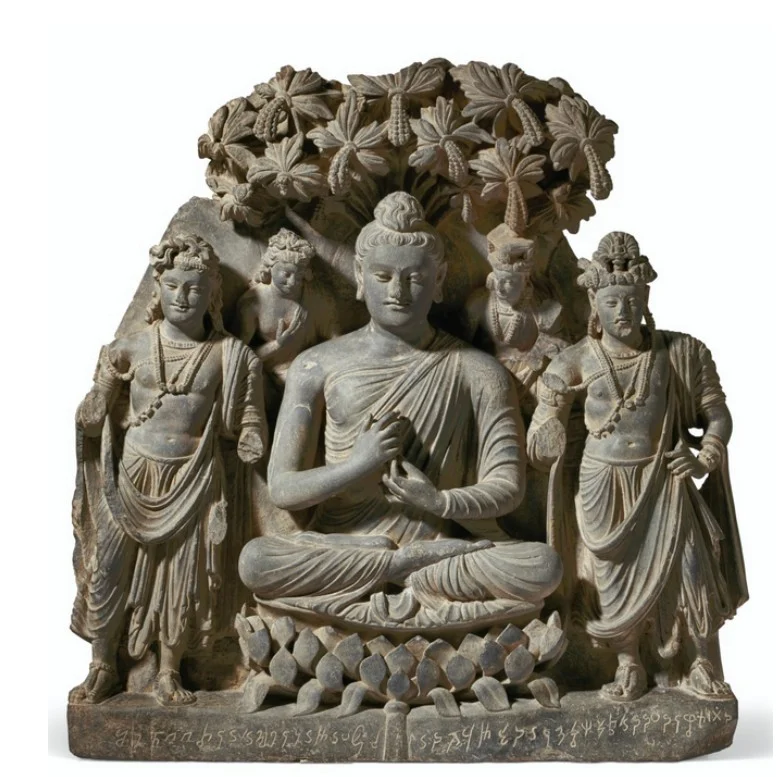Discovery & Provenance
Discovered in 1833 CE (2376 BE) by Charles Masson, a British explorer, during his excavations in the Swat Valley, Pakistan. The vase was found among ruins in Bajaur, a small but historically significant Buddhist site.
Inscription Details
Material: Polished clay vase with a Kharoṣṭhī inscription encircling its body.
Language: Prakrit (with some Sanskrit influence).
Script: Kharoṣṭhī (typical of Gandharan Buddhist inscriptions).
Date: ~60–160 CE (600–700 BE), based on paleography and historical context.
Inscription Text & Translation
Original (Kharoṣṭhī Script):
(Transcribed from Kharoṣṭhī to Roman script for readability)
𐨯𐨎𐨬𐨟𐨿𐨯𐨪𐨀𐨅 𐨟𐨿𐨪𐨅𐨮𐨛𐨁𐨨𐨀𐨅 𐩅 𐩅 𐩅 𐩀 𐩀 𐩀 𐨨𐨱𐨪𐨩𐨯 𐨀𐨩𐨯 𐨀𐨟𐨁𐨡𐨯 𐨐𐨪𐨿𐨟𐨁𐨀𐨯 𐨨𐨯𐨯 𐨡𐨁𐨬𐨯𐨀𐨅 𐨮𐨆𐨜𐨭𐨀𐨅 𐨀𐨁𐨨𐨅𐨞 𐨕𐨅𐨟𐨿𐨪𐨁𐨐 𐨐𐨿𐨮𐨞 𐨀𐨁𐨡𐨿𐨪𐨬𐨪𐨿𐨨𐨅 𐨐𐨂𐨨𐨪𐨅 𐨀𐨤𐨿𐨪𐨕𐨪𐨗𐨤𐨂𐨟𐨿𐨪𐨅
Saṃvatsare trisatime 20 20 20 1 1 1 mahārāyasa ayasa atidasa karatiasa māsasa divase ṣoḍaśe imena cetrika kṣaṇa Indravarme kumāre Apracarājaputre𐨀𐨁𐨨𐨅 𐨧𐨒𐨬𐨟𐨆 𐨭𐨐𐨿𐨩𐨨𐨂𐨞𐨁𐨯 𐨭𐨪𐨁𐨪 𐨤𐨿𐨪𐨡𐨁𐨛𐨬𐨅𐨟𐨁 𐨛𐨁𐨀𐨀𐨅 𐨒𐨧𐨁𐨪𐨀𐨅 𐨀𐨤𐨿𐨪𐨡𐨁𐨛𐨬𐨁𐨟𐨤𐨿𐨪𐨬𐨅 𐨤𐨟𐨅𐨭𐨅 𐨦𐨿𐨪𐨨𐨿𐨨𐨤𐨂𐨙𐨆 𐨤𐨿𐨪𐨯𐨬𐨟𐨁 𐨯𐨢 𐨨𐨡𐨂𐨞 𐨪𐨂𐨑𐨂𐨞𐨐𐨀 𐨗𐨁𐨤𐨂𐨟𐨿𐨪𐨀𐨅 𐨀𐨤𐨿𐨪𐨕𐨪𐨗𐨧𐨪𐨿𐨩𐨀𐨅
ime bhagavato Śākyamuniś śarīra pratiṣṭhaveti ṣṭhite gambhīre aparapratiṣṭhitaprave padeśe brāhmaṇapuṇyo prasavati saha madhuna Rukhunakā jiputre Apracarājabharye𐨯𐨢 𐨨𐨀𐨂𐨫𐨅𐨞 𐨪𐨨𐨐𐨅𐨞 𐨯𐨢 𐨨𐨀𐨂𐨫𐨞𐨁𐨀𐨅 𐨡𐨮𐨐𐨀𐨅 𐨯𐨢 𐨭𐨿𐨤𐨯𐨡𐨪𐨅𐨱𐨁 𐨬𐨯𐨬𐨡𐨟𐨀𐨅 𐨨𐨱𐨬𐨅𐨡𐨀𐨅 𐨞𐨁𐨐𐨀𐨅 𐨕 𐨒𐨱𐨁𐨞𐨁𐨀𐨅 𐨩 𐨀𐨂𐨟𐨪𐨀𐨅
saha mātuleṇa Rāmakeṇa saha mātulaṇiye Daśake saha śvaśruhi Vasavadattā mahādevā Nikā ca gṛhiṇī yā Uttarā𐨟𐨂 𐨀 𐨤𐨂𐨩𐨀𐨅 𐨬𐨁𐨮𐨸𐨂𐨬𐨪𐨿𐨨𐨯 𐨀𐨬𐨕𐨪𐨩𐨯
pitṛ a pūye Viṣṇuvarmasa avacarayasa𐨪𐨡 𐨬𐨒 𐨯𐨿𐨟𐨿𐨪𐨟𐨅𐨒𐨆 𐨤𐨂𐨩𐨀𐨁𐨟𐨅 𐨬𐨁𐨗𐨩𐨨𐨁𐨟𐨿𐨪𐨆 𐨩 𐨀𐨬𐨕𐨪𐨩 𐨨𐨡𐨂𐨭𐨿𐨤𐨯 𐨧𐨀𐨁𐨡𐨟 𐨤𐨂𐨩𐨁𐨟
bhrātā vaga stratage pūyite Vijayamitro ya avacaraya madhuśvasā Bhaidatā pūyitā𐨀𐨁𐨨𐨅 𐨕 𐨭𐨪𐨁𐨪𐨅 𐨨𐨂𐨪𐨿𐨩𐨐𐨫𐨁𐨞𐨟𐨅 𐨠𐨂𐨦𐨂𐨟𐨅 𐨐𐨁𐨜𐨤𐨜𐨁𐨱𐨪𐨁𐨀 𐨀𐨵𐨁𐨩𐨅 𐨀𐨱𐨅𐨛𐨁 𐨨𐨗𐨁𐨨𐨨𐨁 𐨤𐨿𐨪𐨟𐨁𐨛𐨬𐨞𐨨𐨁 𐨤𐨿𐨪𐨟𐨁𐨛𐨬𐨁𐨯
ime ca śarīre Mūryakaliṇate sthūbute kiṭapiḍihare avahiye aheṭhi majimmi pratiṣṭhāvaṇami pratiṣṭhāvisa𐨬𐨯𐨁𐨀 𐨤𐨎𐨕𐨀𐨁𐨭𐨆
vaśiṣṭha pañcaiśo
Translation:
*"In the 63rd year (of the Azes era), on the 16th day of the month of Kārttika, during an auspicious moment, Prince Indravarman, son of King Apraca, enshrined the relics of the Blessed Śākyamuni Buddha in a deep and secure stupa. He performed this meritorious act alongside:
His mother, Queen Rukhunakā (daughter of King Aji),
His uncle, Rāmaka,
His aunt, Daśakā,
His wife, Vasavadattā,
The noblewoman Mahādevā,
The householder Nikā,
And Uttarā.
This act is also dedicated to:
His father, Viṣṇuvarman,
His brother, Vijayamitra (king of Apraca),
His maternal aunt, Bhaidattā.
These relics are housed in a stupa built by the Mauryas, stored securely in a deep and protected chamber."*
Historical Significance
Confirms the Apraca Dynasty’s Rule:
The inscription mentions King Apraca and his son Indravarman, rulers of a local kingdom in Gandhara.
Mauryan Connection:
Refers to the stupa’s construction by the Mauryas, suggesting an earlier foundation later reused by the Apraca kings.
Buddhist Patronage:
Shows the royal family’s devotion to Buddhism, enshrining relics with elaborate rituals.
Dated to the Azes Era:
The "Year 63" likely refers to the Azes era (starting ~47 BCE), placing this inscription around 16 CE (600 BE).
Current Location
The vase is displayed at the Metropolitan Museum of Art, New York, USA.
Why This Matters
Rare Evidence: One of few inscriptions detailing the Apraca dynasty’s Buddhist patronage.
Cultural Blend: Mixes Indian (Kharoṣṭhī/Prakrit), Greek (Azes era), and Central Asian influences.
Artifact of Looting: Like many Gandharan relics, it reached Western museums via 19th-century colonial collections.
Research Note: The term "Mūrya" (Maurya) is intriguing—was this stupa originally Mauryan, or does it refer to a later guild of builders?































